How biophilic design can influence pupil behaviour and attainment
Christopher Leese, technical director at TG Escapes Modular Eco Buildings, looks at the impact of biophilic design on pupils behaviour and attainment in schools and nurseries
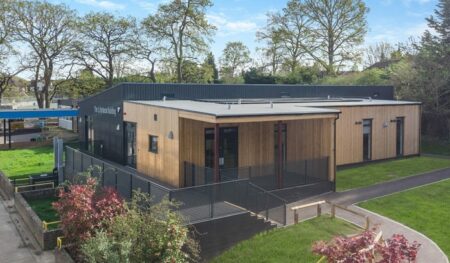
Biophilic design, an innovative approach to architectural and interior design, integrates natural elements such as light, plants, and organic patterns into built environments to foster a connection with nature.
In classrooms, this design philosophy is particularly relevant as it transforms traditional spaces into nurturing environments that enhance wellbeing and learning capacity.
By bringing the outdoors inside, biophilic classrooms can create atmospheres conducive to emotional balance, focus, and creativity.
Pupil behaviour and attainment are vital metrics of educational success, directly influencing academic performance and long-term development.
Positive behaviour fosters collaboration and engagement, while strong attainment reflects mastery of skills and knowledge.
However, these outcomes are often hindered by classroom environments that induce stress and sensory overload.
Biophilic design offers a solution through the use of nature-inspired elements that reduce stress and improve cognitive function.
Integrating biophilic principles into classrooms, such as natural lighting, organic materials, and calming visuals, can profoundly impact students’ cognitive performance, emotional wellbeing, and overall engagement.
Studies have shown that exposure to nature reduces cortisol levels, boosts memory retention, and enhances focus.
For neurodiverse students, or those with Special Educational Needs and Disabilities (SEND), biophilic design creates inclusive spaces that support sensory and emotional regulation, resulting in improved academic progress.
This transformative approach redefines classrooms as sanctuaries for growth and learning.
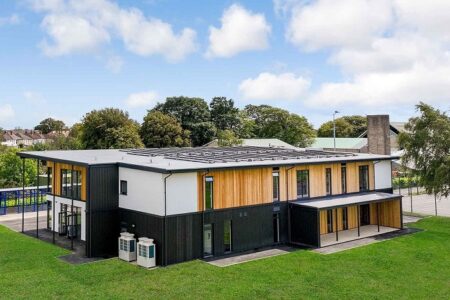
The science
The ancient Greeks understood the connection between nature and learning, exemplified by Aristotle’s Lyceum: a beautiful garden filled with trees and flowing streams.
Biophilic design integrates direct experiences of nature, such as light, ventilation, and sound, alongside biomorphic analogues, like natural patterns, textures, and colours, to create harmonious spaces.
This approach taps into humanity’s innate connection to nature, fostering relaxation and enhancing focus.
Integrating biophilic principles into classrooms, such as natural lighting, organic materials, and calming visuals, can profoundly impact students’ cognitive performance, emotional wellbeing, and overall engagement
Stephen Kellert was one of the first to apply science to the biophilia hypothesis and create actionable architectural design principles. More recently, specifically applied to schools, there is now a research paper entitled ‘The Original Outcomes of Biophilic Design for Schools’ (Browning, W., Determan, J., 2024).
This research highlights the critical benefits as: stress reduction, enhanced emotional wellbeing, increased cognition, and improved performance.
More specifically, it found that biophilic classrooms provide a more-inclusive environment for students with additional support needs.
Stress reduction and emotional wellbeing
Green Street Academy showed a reduction in heart rates and improved heart rate variability within biophilic classrooms.
At Bethel-Hanberry Elementary School, 93% of teachers and 82% of students attributed improved emotional wellbeing to biophilic elements.
And Bethel-Hanberry achieved 91.5% teacher retention, versus the 81.9% district average.
Improved cognition and performance
Eschong Mahone Group found daylight exposure correlated with 18% higher test scores.
At Green Street Academy, sixth-grade maths students in biophilic classrooms outperformed prior cohorts, with test scores rising by 10-15%.
The Philips School Vision study showed that dynamic lighting systems, mimicking natural cycles, improved reading speed by 35% and reduced errors by 45%.
And Bethel-Hanberry saw a 29% drop in chronic absenteeism, from 17.3% to 12.3%.
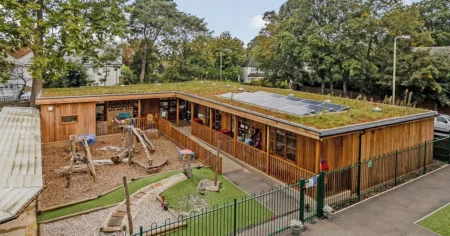
Inclusive environments for Additional Support Needs
Biophilic environments reduced hyperactivity in ADHD students by 76%.
Biophilic environments improved social communication in students with additional needs by 30%.
At Green Street Academy, teachers in biophilic classrooms reported quieter classrooms: a 5dB reduction was observed.
ADHD students in low-noise, fractal-rich environments completed tasks 40% faster.
Implementing biophilic design in classrooms
The real issue is how we can translate these findings into the creation of learning spaces that embody a biophilic classroom environment.
Fortunately, Browning’s previous work developed a toolkit, an extract of which is shown below.
Using this we have been able to develop a strategy for targeting the key outcomes of stress reduction, enhanced cognitive performance, and a more-inclusive environment.
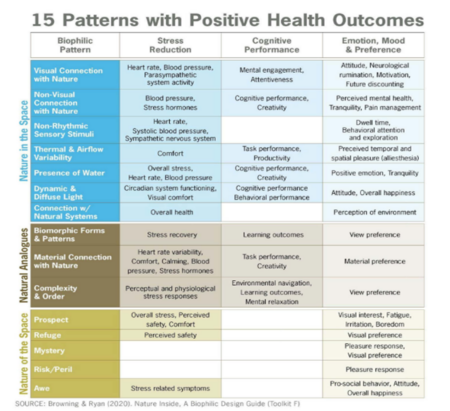
Ventilation, acoustics, and lighting
Ventilation is incredibly important in a classroom environment.
High CO2 levels cause fatigue: for every 1,000ppm increase, student cognitive performance drops by 10-15%.
Current guidance has set a limit of 1500ppm within new classrooms. However, previous testing has shown classroom levels as high as 5000ppm.
The University of Reading’s Ventilation Rates in Schools and Pupils Performance Research indicates that improving ventilation can reduce absenteeism by up to 2.9% and improve standardised test scores by up to 11% in mathematics and 12-13% in reading.
Unfortunately, in an existing classroom, the best we can do is install a CO2 monitor and open windows when the levels get too high.
However, optimal air quality can be consistently achieved by integrating a mechanical ventilation system that will also balance thermal comfort. This should always be considered when refurbishment is being undertaken and is a standard feature of our biophilic classrooms.
Acoustics are another crucial element of a classroom environment.
The Essex study on Acoustics recently found that a classroom with noise levels over 30dB can impact children with SEND. It also found that many classrooms exceed 70dB.
Background noise over 35dB is likely to cause children with ASD to experience sensory overload, resulting in heightened anxiety.
Children with ADHD take, on average, 40% longer to complete a reading task, while children with speech and language disorders experience a 20% drop in comprehension of spoken instructions.
Even within a traditionally-built classroom, there are practical steps that can be taken to improve exposure to natural daylight. These include ensuring that windows are clean and windowsills are clear of clutter; using reflective material such as satin paint on the walls, and augmenting natural light with smart interior lighting when necessary
Furthermore, the Noise in Education study found that noisy classrooms also affect teachers: 65% reported experiencing vocal strain, sometimes leading to chronic conditions.
However, acoustics can be addressed in a number of ways.
Acoustic ceiling tiles can have a massive impact on classroom noise levels, which can be further augmented by acoustic pillows placed above the tiles in the void.
Additionally, a number of companies have now created acoustic wall panels that can be used to display artwork or a biomorphic image, or to act as a noticeboard.
Lighting is another vital component of any learning environment, yet it is often outside the control of the teacher, apart from the on/off switch.
Natural lighting has been shown to improve attendance and cognition by reducing stress, hyperactivity, aggression, and distraction.
The simplest solution lies with nature.
As a day progresses, we experience different lighting levels (lux) and colours (K).
The Philips Lighting Study pinpointed the precise colour, or Kelvin, of lighting conducive to different activities: cool light for focus and reasoning, warm light for calming and creative tasks.
Blue tone can be used to combat fatigue. However, when not adapted for specific tasks, the ideal colour of lighting was found to match the natural colour of daylight, helping support natural circadian rhythms.
A biophilic classroom will always have large windows and glass doors to maximise the penetration of natural light, often supplemented by sun pipes deeper into a building’s interior, and always augmented with dimmable lighting systems that mimic natural daylight patterns.
Biophilic design is not merely an aesthetic choice. It is a proven method for creating learning environments in which students can thrive emotionally and academically
However, even within a traditionally-built classroom, there are practical steps that can be taken to improve exposure to natural daylight. These include ensuring that windows are clean and windowsills are clear of clutter; using reflective material such as satin paint on the walls, and augmenting natural light with smart interior lighting when necessary.
The whole room should have a lighting level between 300-500 lux: and achieving this can result in a 16% boost to performance.
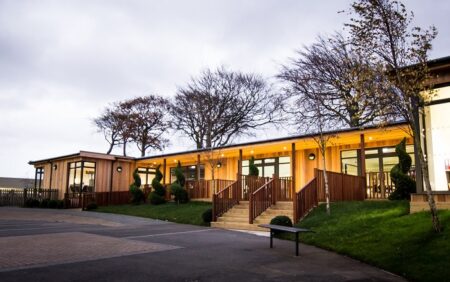
Biomorphic design and natural views
Biomorphic design is the use of natural materials, patterns, colours, and textures to allow our brain to see what it expects.
Humans have been around for approximately 300,000 years, and a few have lived in cities for just 10,000 of those.
We have only lived in large-scale urbanised environments for the last 250 years, and our brains have yet to catch up.
We all have our fight-or-flight reflex triggered by the feeling that something isn’t right. When all we can see are alien objects, our bodies become stressed, and the reflex is activated.
Biomorphic design reverses that response by adding what our ancestral neural pathways expect to see, muting the subconscious stress reflex, thus enhancing focus and creating calmer, more-relaxed environments where we can learn.
This is perhaps the easiest way to introduce biophilic design into our classrooms. Replace white walls with pastoral colours such as greens, browns, and blues and use shapes like leaves and trees in displays to help create the shapes our brains expect.
Select wood or wood-effect furniture to provide the texture, colour, and patterns that we crave and bring plants into the classroom – even artificial pot plants will do the job.
In addition, take notice of the views from the windows and, where possible, make the most of natural green outlooks, or maybe add some timber cladding to any buildings blocking the view.
Finally, the clever use of canopies can create safe, weatherproof outdoor learning environments.
We can do lots to improve the indoor environment, but there is no true replacement for actually being outside amid nature.
Benefits for all
Biophilic design is not merely an aesthetic choice. It is a proven method for creating learning environments in which students can thrive emotionally and academically.
Great design is good for all and bridging the gap between nature and the classroom can help schools unlock the potential of every pupil.
However, students with SEND and SEMH often have a lower tolerance for sensory overload and distractions. Removing these barriers to learning through biophilic design can have a profound impact upon these children while fostering a culture of inclusivity.
